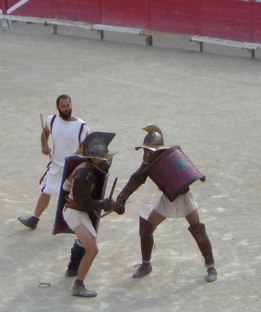Today we welcome author Rosemary Goodacre, who tells us about her debut novella, A Fortnight is not Enough, set in beautiful Provence, and her connection with the area.
 Welcome to the Write Minds blog, Rosemary. This must have been an exciting time for you with the publication of your first novella. Did you do anything to celebrate?
Welcome to the Write Minds blog, Rosemary. This must have been an exciting time for you with the publication of your first novella. Did you do anything to celebrate?
I’m really thrilled with the news but haven’t done anything special yet to celebrate. I’m busy with social media publicity and current writing projects.
You describe the Provençal town of Pont-César in some detail, its narrow streets, market, cafes, Roman arena and so on. Is it based on any particular town or towns?
When we visited the south of France in 2016 we stayed in Arles, on the Rhône, the main inspiration for Pont-César. In the arena there you can take part in ‘gladiator training!’
Did you visit anywhere else in Provence?
We visited the Carmargue, a marshy coastal area where flamingos live wild, and Avignon, where you can see the famous bridge (no longer quite complete) and the palace, occupied in the Middle Ages by certain Popes.

‘Gladiator training’ in Arles
Imogen’s French in the book is described as being good. Are we right in thinking you also speak French
My father’s family came from the continent and my grandparents spoke French at home. I’m not fluent but I can keep up a conversation. My cousin comes from Liège in Belgium, where they speak French. She now lives in France, in the Gers, not far from the Pyrenees, and we went on to visit her in 2016.
The two main characters, Imogen and Jules, are both artists. Have you ever dabbled with painting yourself?
I’m afraid it was only dabbling. I knew what I wanted to paint but didn’t have the skill to execute it well. I have friends and relatives who paint and it’s a lovely career or pastime.
Several Impressionists are mentioned in your story as being on display in the gallery. Do you have a favourite Impressionist artist?
I haven’t got a favourite but I love their images of sunshine and sparkling rivers. Their lives were probably more challenging than the idyllic pictures suggest.
Jules’ maman cooks some tasty dishes for Imogen. What French food do you particularly enjoy?
There’s a very wide variety of French food, including, thriftily, creatures and parts of creatures we don’t normally eat. In Toulouse I resisted trying the popular dish of Gizzards. Most French food is delicious, though. I love the healthy Mediterranean diet of fruit, vegetables and fish.
What are you working on next?
I’ve recently completed a romance entitled The Day of the Dolly Bird, set in London in the Swinging Sixties. It has been critiqued by a professional novelist through the New Writers’ scheme of the Romantic Novelists’ Association, and received a largely favourable report. At present I’m writing a historical novel set in World War I.
Thank you for taking the time to answer our questions, Rosemary. All the best with A Fortnight is not Enough.
Many thanks for inviting me to your blog, Francesca and Elaine.
Find Rosemary on Facebook and Twitter
A Fortnight is not Enough
 Have you ever enjoyed a holiday so much you could not bear to go home?
Have you ever enjoyed a holiday so much you could not bear to go home?
When 18 year old Imogen from London meets Jules in the south of France she is painting a view of the river and finds he is an artist too. As a student he earns a little by restoring paintings at the nearby gallery. She extends her three day stay to a fortnight. She loves the warm sunshine and the old town with its Roman remains.
As she becomes increasingly attracted to Jules she is unwilling to return home, where her older boyfriend Luke employs her in his photography gallery, obsessed with furthering his own ambitions. She travels to the airport but then impulsively misses her flight.
Will she need to return to London or can she and Jules find a way to allow her to stay? When the gallery is threatened, fate takes a hand…
Published by US publisher, Books to Go Now and available from Kobo, Amazon UK and Amazon US

 It’s not only Luca who gets to hog the limelight. The third short story I had published, A New Beginning, in The Weekly News back in 2009, featured teenager Peter. It’s no coincidence that Peter is the name of my oldest son. Since then each of my four children have appeared in at least one story, though not always under their own names. Using them as models for characters has been useful though.
It’s not only Luca who gets to hog the limelight. The third short story I had published, A New Beginning, in The Weekly News back in 2009, featured teenager Peter. It’s no coincidence that Peter is the name of my oldest son. Since then each of my four children have appeared in at least one story, though not always under their own names. Using them as models for characters has been useful though.
